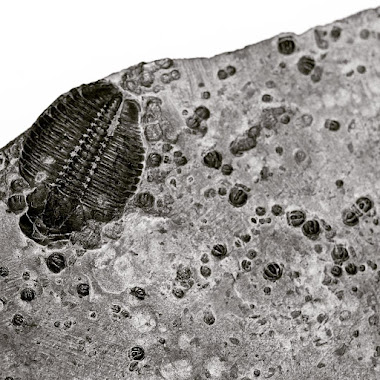Cambrian trilobite Asaphiscus wheeleri (Meek 1873) from Utah
(USA) (Photo: Jordi Sanchez).
Trilobites are one of the most iconic groups of arthropods in the fossil record, known for their diversity and abundance during the Paleozoic era. Within this group, agnostid trilobites, and in particular the genus Peronopsis, exhibit unique characteristics that make them fascinating to both paleontologists and enthusiasts of Earth's history.
What is Peronopsis?
Peronopsis is a genus of trilobites that lived during the Middle and Late Cambrian, approximately 500 million years ago. Unlike other trilobites that were benthic (living on the seafloor), members of this genus likely had a planktonic lifestyle, floating in the water column or swimming near the ocean floor.
Peronopsis interstrictus (White, 1874) from the Wheeler Formation, Millard County (USA) (Photo: Jordi Sánchez).Key Characteristics of Peronopsis
- Small size, generally no larger than 1 cm in length.
- Symmetrical shape, with the cephalon (head) and pygidium (posterior section) being nearly identical in size, making it difficult to distinguish the front from the back.
- Lack of eyes, suggesting a life in deep waters or low-light environments.
- Only two thoracic segments, giving it a compact appearance.
- Global distribution, with fossils found in North America, Europe, Asia, and Australia.
Why is Peronopsis Important?
In addition to being a unique group within trilobites, Peronopsis has great importance in biostratigraphy, as its presence in certain rock strata helps geologists date Cambrian sedimentary layers. Its rapid evolution and widespread distribution make it a key index fossil for studying the history of ancient oceans and marine ecosystems from millions of years ago.
The Mystery of Its Lifestyle
Agnostid trilobites, such as Peronopsis, have sparked debates among scientists regarding their ecology. Their small size, lack of eyes, and presence in deep marine deposits suggest they may have been planktonic, drifting in the water column rather than living on the seafloor. However, other studies indicate they could have been nektobenthic, meaning they swam close to the ocean bottom.
Mass mortality plate with the cambrian trilobite Elrathia kingii and the small agnostid Peronopsis interstrictus (Photo: Jordi Sanchez).The genus Peronopsis is an excellent example of trilobite diversity and adaptation during the Cambrian. Its peculiar morphology and possible planktonic lifestyle make it one of the most enigmatic species in the world of fossils. For paleontology enthusiasts, these small trilobites provide a window into Earth's ancient seas, where life was beginning to diversify in remarkable ways.
%20and%20Elrathia%20kingii%20(Meek%201870)%20from%20Utah%20(USA).(About%20505%20million%20years%20old)...%23cambrian%20%23trilobites%20%23cambrianperiod%20%23trilobite%20%23fossilized%20%23arthropod%20%23paleonto.jpg)

%20and%20Brachyaspidion%20microps%20(Robison,%201971)%20from%20the%20Wheeler%20Formation,%20%23MillardCounty%20%23usa..%23paleontology%20%23paleontologist%20%23fossilcl.jpg)


%20Cleoniceras%20aff%20besairiei%20(Collingion,%201949)%20from%20Madagascar..Discovered%20in%20the%20Mahajanga%20province%20of%20Madagascar,%20these%20ammonites%20have%20taken%20on%20a%20brilliant,%20rainbow%20iridescence.%20Th-2.jpg)
%20sea%20urchin%20Micraster%20coranguinum%20Leske,%201778%20from%20Lleida%20(Catalonia)..%20Fossil%20in%20situ.%20Fossil%20preparation%20with%20water%20and%20toothbrush.%20Fossil%20preparation%20through%20chemical%20treatment%20using%20pot.jpg)

No comments:
Post a Comment